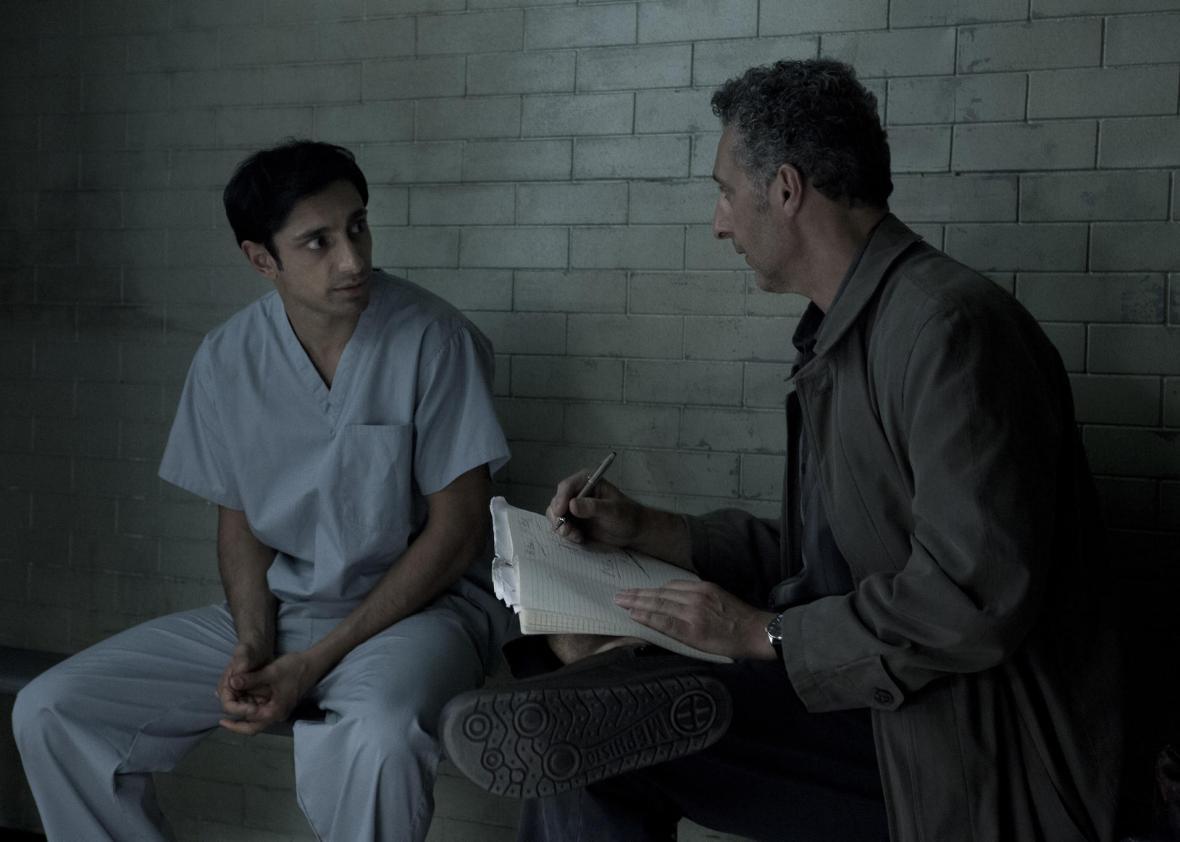Upon its premiere, The Night Of drew comparisons to great TV shows ranging from HBO classics like The Wire and Oz, as a prison drama concerned with the insufficiencies of the criminal justice system, to more recent examples like American Crime and The People vs. O.J. Simpson, as a stylish, elongated procedural shrouded in ambiguity. But some critics also noticed a far less common point of comparison for scripted TV: documentaries, and specifically the recent phenomena of The Jinx, Serial, and—perhaps most notably—Making a Murderer. As an atmospheric (and occasionally infuriating) crime drama, The Night Of stood out for its methodical pace and—despite the fact that it is clearly fiction, not “true crime”—its general commitment to realism.
The show’s dreary noir aesthetic was paired with a narrative that was comfortable working in shades of gray. The series depicted Naz’s transformation in prison as a matter of necessity—his ability to survive otherwise was doubtful—but also as a thread in its suggestive reading of the character as at once a potential killer and potential innocent. It introduced red herrings as a way to play with familiar genre conventions, while keeping the focus on its compelling main characters, from defense attorney John Stone (John Turturro) and his reluctant partner Chandra Kapoor (Amara Karan) to retiring detective Dennis Box (Bill Camp) and pragmatic prosecutor Helen Weiss (Jeannie Berlin). And it moved slowly, spending as much time on John’s struggles with eczema and cat allergies as it did on unfurling the facts of the case. Through its idiosyncrasies and its quirks, The Night Of felt real.
Unfortunately, the finale—titled “The Call of the Wild”—felt less so. The episode introduced a new suspect, the victim’s ex-boyfriend. All signs pointed to him having killed Andrea by the finale’s end. And the hints were all over the place—in credit card statements, on security cameras, in pictures and information from his past. Conveniently, Box, Weiss, Stone, and Kapoor alike were completely blind to this man until Episode 8; Andrea’s coincidental bump-ins on “the night of” with a trio of knife-wielding menaces were meant to distract, not inform. Effectively, creators Richard Price and Steve Zaillian manipulated their timeline for dramatic effect and in so doing contorted the case’s processes in a way that felt more convenient than lifelike. But that raises the question: How much should it matter?
While Serial and The Jinx were emotionally manipulative in their own ways; the selective presentation of facts by Making a Murderer has been the most intensely divisive. The Netflix series’ commitment to telling a story through a specific lens in order to elicit a specific response prompted questions about the responsibilities of storytelling with real-world implications. It arguably skirted uncomfortable territory in order to maintain its easy emotional appeals. And that’s where it aligns most closely with The Night Of.
In many ways, chronological manipulations helped The Night Of clarify its core arguments. Naz’s slight air of menace—bolstered by various reveals about his past as well as the show’s general refusal to exonerate him—was undercut in the finale by a “smell of innocence,” as fellow Rikers inmate Freddy (Michael Kenneth Williams) called it, that rendered his subsequent release as a lonely, hardened drug addict all the more tragic. And Box’s sudden awakening from retirement allowed for some poignant character development for him. More broadly, the series’ transition from realistically charting the step-by-step grind of a high-profile murder case to introducing an implausibly dramatic twist felt like a betrayal of its original aim, a full leap into the whodunnit crime-fiction genre it had only toyed with in previous episodes.
Over the course of The Night Of, the prosecution—with flimsy evidence and limited resources—went after Naz in a way that seemed both inevitable and unconscionable. Box’s nagging feeling that Naz could be innocent never went anywhere because, as would most likely be the case in a real trial, he couldn’t prove otherwise. His abrupt discovery of Andrea’s ex-boyfriend, though, said a lot more about the demands of closure in serial drama than it did about real-life legal process. It made for a cozily ironic and appropriately unsatisfying ending but also a manipulative one. Of course, this is storytelling, and The Night Of was under no obligation to play totally fair. But like Making a Murderer, its systemic critique didn’t quite hold up to scrutiny in the end. Its doling-out of information proved selective and partial. Like Making a Murderer, it used facts and timelines to its dramatic advantage, rather than in accordance with its world’s actual complexities. And like Making a Murderer, The Night Of went out as agonizingly good entertainment that, ultimately, undermined its greatest strength: exposing the perils of our criminal justice system, one credible step at a time.
